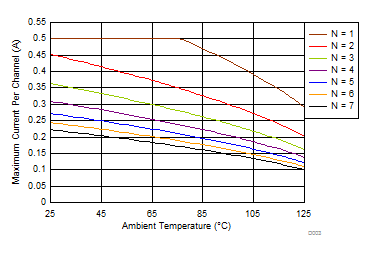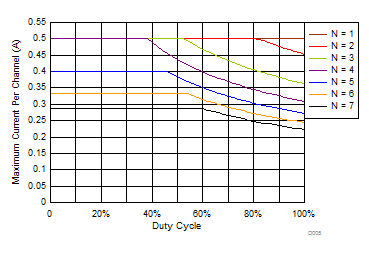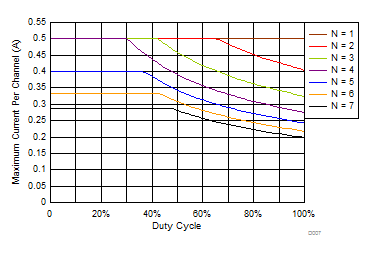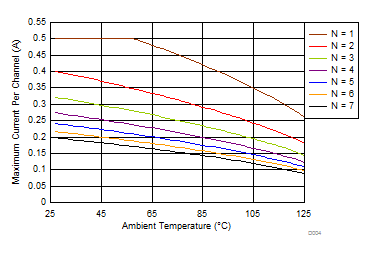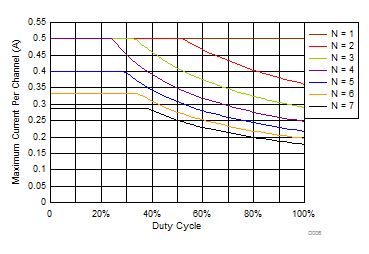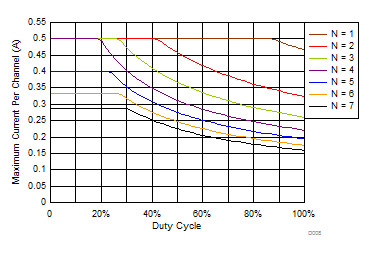SLRS066D January 2014 – March 2016 TPL7407L
PRODUCTION DATA.
- 1 Features
- 2 Applications
- 3 Description
- 4 Revision History
- 5 Pin Configuration and Functions
- 6 Specifications
- 7 Detailed Description
- 8 Application and Implementation
- 9 Power Supply Recommendations
- 10Layout
- 11Device and Documentation Support
- 12Mechanical, Packaging, and Orderable Information
パッケージ・オプション
メカニカル・データ(パッケージ|ピン)
サーマルパッド・メカニカル・データ
- D|16
発注情報
6 Specifications
6.1 Absolute Maximum Ratings
at 25°C free-air temperature (unless otherwise noted) (1)| MIN | MAX | UNIT | ||
|---|---|---|---|---|
| VOUT | Pins OUT1-OUT7 to GND voltage | –0.3 | 42 | V |
| VOK | Output Clamp diode reverse voltage(2) | –0.3 | 42 | V |
| VCOM | COM pin voltage(2) | –0.3 | 42 | V |
| VIN | Pins IN1-IN7 to GND voltage (2) | –0.3 | 30 | V |
| IDS | Continuous drain current per channel(3) (4) | 600 | mA | |
| IOK | Output clamp current | 500 | mA | |
| IGND | Total continuous GND-pin current | –2 | A | |
| TA | Operating free-air temperature range | –40 | 125 | °C |
| TJ | Operating virtual junction temperature | –40 | 150 | °C |
| Tstg | Storage temperature range | –65 | 150 | °C |
(1) Stresses beyond those listed under "absolute maximum ratings" may cause permanent damage to the device. These are stress ratings only, and functional operation of the device at these or any other conditions beyond those indicated under "recommended operating conditions" is not implied. Exposure to absolute-maximum-rated conditions for extended periods may affect device reliability.
(2) All voltage values are with respect to the GND/substrate pin, unless otherwise noted.
(3) Maximum power dissipation is a function of TJ(max), θJA, and TA. The maximum allowable power dissipation at any allowable ambient temperature is PD = (TJ(max) – TA)/θJA. Operating at the absolute maximum TJ of 150°C can affect reliability.
(4) The package thermal impedance is calculated in accordance with JESD 51-7.
6.2 ESD Ratings
| VALUE | UNIT | |||
|---|---|---|---|---|
| V(ESD) | Electrostatic discharge | Human-body model (HBM), per ANSI/ESDA/JEDEC JS-001(1) | ±2000 | V |
| Charged-device model (CDM), per JEDEC specification JESD22-C101(2) | ±500 | |||
(1) JEDEC document JEP155 states that 500-V HBM allows safe manufacturing with a standard ESD control process. Manufacturing with less than 500-V HBM is possible with the necessary precautions.
(2) JEDEC document JEP157 states that 250-V CDM allows safe manufacturing with a standard ESD control process. Manufacturing with less than 250-V CDM is possible with the necessary precautions.
6.3 Recommended Operating Conditions
Over operating temperature range| MIN | MAX | UNIT | ||
|---|---|---|---|---|
| VOUT | OUT1 – OUT7 pin voltage for recommended operation | 0 | 40 | V |
| VCOM | COM pin voltage range for full output drive | 8.5 | 40 | V |
| VIL | IN1- IN7 input low voltage ("Off" high impedance output) | 0.9 | V | |
| VIH | IN1- IN7 input high voltage ("Full Drive" low impedance output) | 1.5 | V | |
| TJ | Operating virtual junction temperature | –40 | 125 | °C |
| IDS | Continuous drain current | 0 | 500 | mA |
6.4 Thermal Information
| THERMAL METRIC(1) | TPL7407L | UNIT | ||
|---|---|---|---|---|
| SOIC (D) | TSSOP (PW) | |||
| 16 PINS | 16 PINS | |||
| θJA | Junction-to-ambient thermal resistance | 91.9 | 115.2 | °C/W |
| θJCtop | Junction-to-case (top) thermal resistance | 50.1 | 49.5 | °C/W |
| θJB | Junction-to-board thermal resistance | 49.4 | 60.8 | °C/W |
| ψJT | Junction-to-top characterization parameter | 18.6 | 8.5 | °C/W |
| ψJB | Junction-to-board characterization parameter | 49.1 | 60.2 | °C/W |
(1) For more information about traditional and new thermal metrics, see the Semiconductor and IC Package Thermal Metrics application report (SPRA953).
6.5 Electrical Characteristics
TJ= –40°C to 125°C; Typical Values at TA=TJ= 25°C| PARAMETER | TEST CONDITIONS | MIN | TYP | MAX | UNIT | ||
|---|---|---|---|---|---|---|---|
| VOL (VDS) | OUT1- OUT7 low-level output voltage | VIN ≥ 1.5 V | ID = 100 mA | 200 | 320 | mV | |
| ID = 200 mA | 420 | 650 | |||||
| IOUT(OFF) (IDS_OFF) | OUT1- OUT7 OFF-state leakage current | VOUT = 24 V, | VIN ≤ 1.0 V | 10 | 500 | nA | |
| VF | Clamp forward voltage | IF = 200 mA | 1.4 | V | |||
| IIN(off) | IN1- IN7 Off-state input current | VINX= 0 V | VOUT = 40 V | 500 | nA | ||
| IIN(ON) | IN1- IN7 ON state input current | VINX=1.5 V - 5.0 V | 10 | μA | |||
| ICOM | Static current flowing through COM pin | VCOM = 8.5 V - 40 V | 15 | 25 | μA | ||
6.6 Switching Characteristics
Typical Values at TA=TJ= 25°C| PARAMETER | TEST CONDITIONS | MIN | TYP | MAX | UNIT | ||
|---|---|---|---|---|---|---|---|
| tPLH | Propagation delay time, low- to high-level output | VINX ≥ 1.65 V, Vpull-up = 24 V, Rpull-up = 48 Ω | 350 | ns | |||
| tPHL | Propagation delay time, high- to low-level output | VINX ≥ 1.65 V, Vpul-lup = 24 V, Rpull-up = 48 Ω | 350 | ns | |||
| Ci | Input capacitance | VI = 0, | f = 100 kHz | 5 | pF | ||
6.7 Typical Characteristics
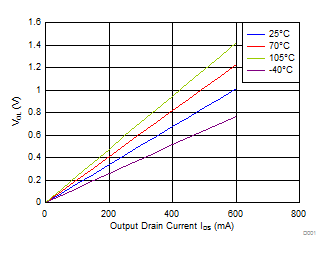
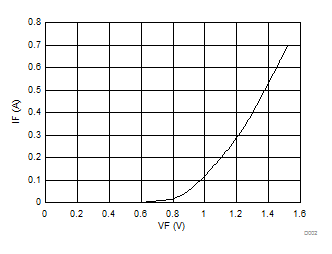
6.8 Thermal Characteristics
